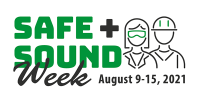AIHA Releases Revised COVID-19 Guidelines
The AIHA (formerly the American Industrial Hygiene Association) announced the release of revised Back to Work Safety (BTWS) Guidelines. Updates to the revised guidelines include alignment with the Centers for Disease Control and Prevention’s (CDC) new recommendations regarding vaccinated individuals; the hierarchy of health and safety controls; and references to current scientific evidence indicating that […]










